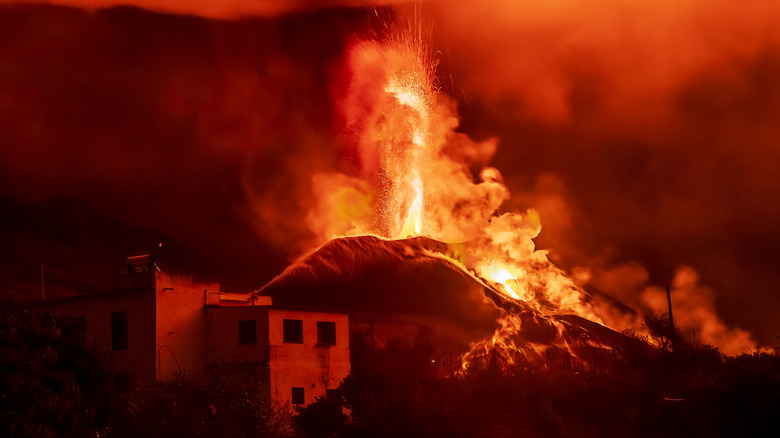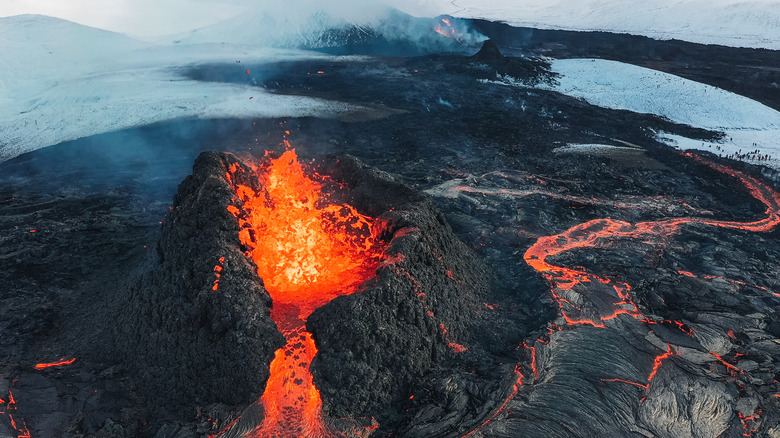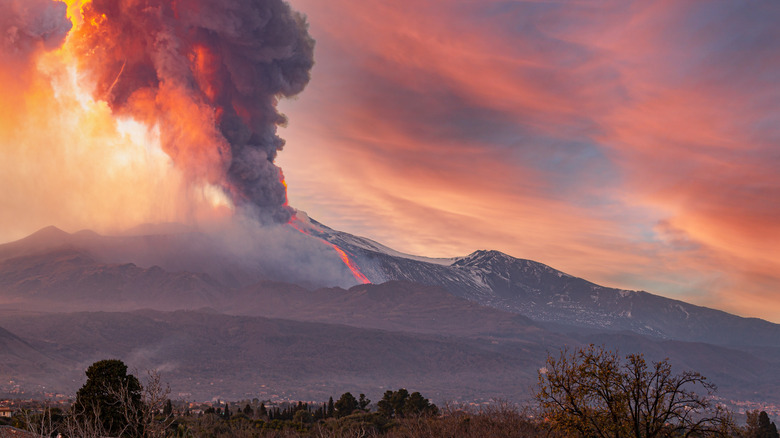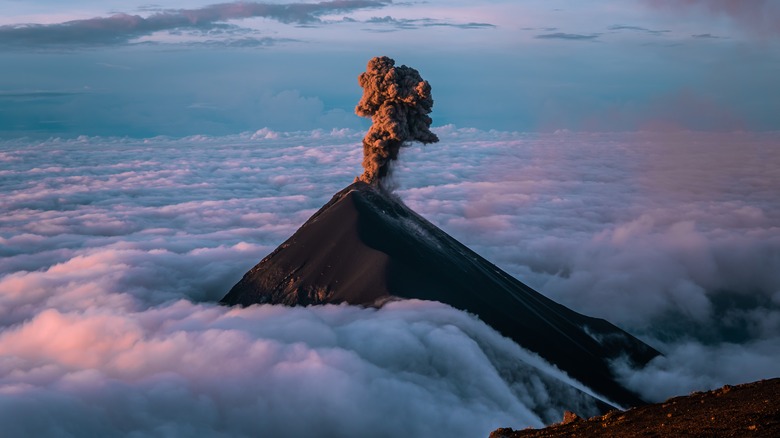This Is How Volcanic Eruptions Affect Your Body
News flash, people: If a volcano is going to erupt, don't be nearby. Just ask folks on La Palma, the westernmost Canary Island west of Morocco. Last year, in 2021, La Palma's volcano erupted for months straight, coating the landscape and homes in "runny" lava, suffocating the island in meters-high ash, spilling molten rock into the ocean and releasing toxic gases, and generally ruining the lives of the island's 80,000 inhabitants, as the BBC recounts. Shockingly, no one was killed or even injured. The Spanish government has allocated 225 million euros to the island's recovery.
Such volcanic consequences aren't anything remotely new. The ancient Roman city of Pompeii provides us with the clearest, most well-preserved example of what can happen to people caught in the aftermath of a volcanic eruption, as History describes. In 79 C.E., Mt. Vesuvius belched out enough ash to bury the entire city of Pompeii until it was first excavated about 1,670 years later in 1748. Vesuvius' destruction was so rapid and so thorough that we've got the intact remains of Pompeii's 12,000 inhabitants encased in ash-enclosed death poses with arms wrapped around loved ones.
Volcanoes are a perfect example of the fragility of human bodies, lives, and civilizations. They're also just another natural, earthly, geological phenomenon that have, along with earthquakes, formed the very ground we step on, as the British Geological Survey explains. But for the living, volcanoes spell doom, pain, and death in any number of ways.
Devoured by flesh-melting lava
You've got to admit: If you were standing face-to-face with a caldera's bubbling cauldron when it started to jettison flecks of 2,120-degree lava past your head (per Live Science), you'd rightfully freak out. But if those flecks started to geyser, or even ooze — well, how fast can you run? Because if it's not faster than a 30-mph lava flow, you're going to get consumed from the feet up, down to the bone (per the National Parks Service). It wouldn't be a good time. And yet, thousands of tourists flock to get glimpses of active volcanoes every year. They hike pilgrim-like, up-sloping rockfaces to peer into the maw of a sleeping god, as The Guardian shows. And don't expect that god to spit you out like Tom Hanks in 1990's "Joe Versus the Volcano."
Okay, to be fair, one touch from lava wouldn't instantly dissolve your flesh. As Oregon State University explains, you'd get a nasty burn, but injuries depend on the amount of lava "coverage" and length of contact with your skin. Hint: longer is worse. This is especially true because lava starts to cool when it's expelled and develops a hard outer skin that can trap things inside, per Honolulu Civil Beat. Sciencing explains that lava flows basically devour everything in their path: homes and possessions, farmland and food supplies, wildlife and their habitats, plantlife, you name it. The ramifications of such devastation can far outstrip the destructiveness of direct contact with lava.
Smothered in ashfall
Here's a question for you: Are you into inhaling glass? Right, didn't think so. How about minerals or microns-long rock shards? Then don't get anywhere near volcanic ash, which isn't actually ash at all, as Forbes explains. When folks think of ash, they're usually envisioning combustive ash, the soft, powdery stuff left behind when you burn something. That's made of calcium carbonate, nitrogen, potash, and minerals and oxides. Volcanic ash, on the other hand, is composed of coarse, rough little chips of whatever stony materials get blasted up by the bellows of Earth during a volcanic eruption. It's insoluble — it doesn't dissolve in contact with water — and therefore can't be washed away. Ashfall, as it's called, has to be scooped up bit by bit and properly disposed of.
As Sciencing says, people caught in ashfall can develop chronic breathing and throat problems. This is especially true if someone already has a lung disorder like asthma. In fact, the American Lung Association advises assuming "that your lung condition may deteriorate" and recommends having extra medication handy, your insurance card, an asthma action plan for you or others to use, and more. They also list a litany of dos and don'ts for those caught in an eruption, including common sense things like staying inside and not relying on masks for complete protection. Frontiers in Immunology also describes how volcanic ash can cause "sustained inflammation, lung fibrosis, and cancer" because the aforementioned silicates get stuck in the lungs.
Climate-changing destruction
So far we've covered burning lava and rocky ash, but volcanic eruptions can have far more serious, far-reaching consequences on human life beyond the initial eruption. The United States Geological Survey (USGS) and NASA discuss how volcanic eruptions can be so strong and so severe that they alter Earth's climate. Most of the ash shot into the atmosphere — injected ash — falls to the ground within days, maybe weeks. But gases released into the stratosphere? Not so much.
Out of all the gases released from the guts of the planet during a volcanic explosion, two gases can have powerful, and contradictory, effects on Earth's climate. Carbon dioxide, as we know, is a greenhouse gas that heats up the atmosphere — this compounds problems like global warming. But sulfur dioxide? It condenses into a fine mist — a sulfate aerosol — that reflects sunlight and decreases Earth's temperature. Plus, the shorter-term cloak of gray sky ash reduces Earth's temperature even further. Various eruptions throughout the 20th century alone, per the USGS, have each decreased Earth's overall temperature by half a degree Fahrenheit or more for a period of one to three years. This might affect crop yields on an annual basis, but if enough volcanoes go off, or have potent-enough eruptions? There's a much more serious risk to not only our life and civilization but all planetary life.
So what's the lesson here? Volcanoes are powerful. Don't touch lava, don't inhale ash, and otherwise keep your fingers crossed.



